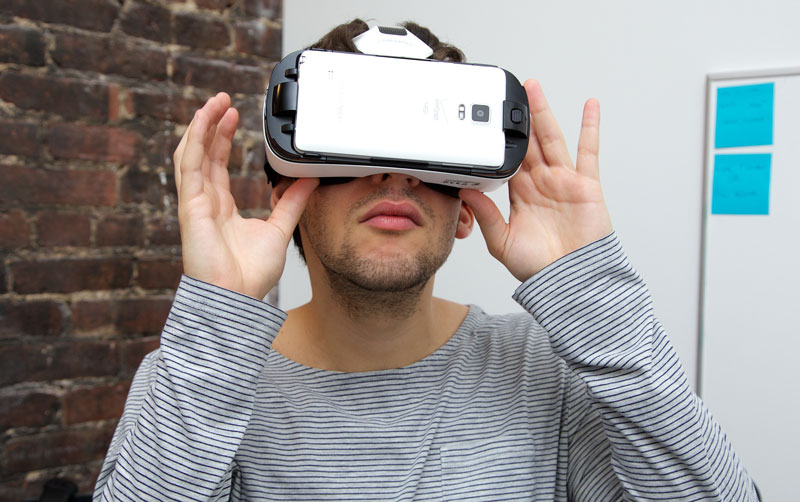Realizing the Virtual

If your smartphone is smart enough—and most of them are these days—you can slide it into a little cardboard box, peer through a pair of specially constructed lenses, and you’re suddenly in the middle of another world. As you move your little box up and down and side to side, the images appear in front of you, behind you, above you, and below you.
The entertainment medium commonly called “virtual reality,” or VR, has been around for decades—the Air Force used it in flight simulators as early as the 1970s. But since its inception, VR technology has been too expensive and not technologically advanced enough for mass marketing.
Recently, however, the cost of virtual reality equipment has dropped significantly, and a team of young Vassar alumni and students are putting themselves on the cutting edge of the emerging VR revolution.
Harris Gordon ’15, Matthew Griffiths ’16, Casey Hancock ’16, and Alejandro Dinsmore ’15 are co-owners of EEVO (shorthand for Entertainment Evolved), a New York City–based firm that was born two years ago on the Vassar campus. The company has developed software and made business connections that will soon enable EEVO to distribute VR content—movies, advertisements, educational tools, and perhaps some platforms that haven’t been dreamed up yet—to mass audiences. Another Vassar grad, Daniel Sohval ’13, is the firm’s JavaScript developer, and two other alums, Robert Green ’90 and Jordan Hoffner ’91, are members of EEVO’s board of advisors.

Green was instrumental in connecting the firm with investors, who have provided one million dollars in working capital. “The secret to the success of any start-up is a combination of timing, luck, and skill, and these guys had all three,” he says.
Dinsmore, the company’s chief executive officer, says he’s convinced EEVO is uniquely positioned to take advantage of the coming VR wave. “We started a little earlier than other people in the field, and we’ve been looking a year or two or three ahead to figure out what we’ll need to do to compete,” he says.
EEVO started out as VCEMO, a company Dinsmore and his partners formed in May 2014 when they were all still students at Vassar. At the time, they envisioned the company as a sort of YouTube for virtual reality, a place on the Internet where anyone could post VR content. Since then, the company’s mission, like its name, has changed.
“We’ve pivoted away from the YouTube model and moved on to something more like Netflix,” Dinsmore explains. “We’re working with content providers who are producing the highest-quality products, and we’re licensing the ones we want to work with. Companies like Pixar and Lucasfilm are starting to develop VR content for their studios. Virtual reality is about to take off like online video did 10 years ago. It’s not a matter of if, but when.”
Initially, EEVO launched its platform as an app on the Gear VR store but now it has plans to expand into browser versions, and the firm is already drawing raves from some significant people in the industry.
Video and VR artist James George, who won an award at the 2014 Tribeca Film Festival for a VR short film, has been developing projects with EEVO for several months. “VR is a growing but still-small universe, and I’d heard good things about EEVO as a company that had the right philosophy and that was run by people you could trust,” George says. “They’re out in front of others in the industry in terms of software for interactivity and sound quality, things you need for high-quality content.”
Dinsmore says he believes EEVO is well positioned to make money quickly as the VR revolution takes off, both through licensing deals for its soon-to-be-patented software and through the sharing of revenue generated by the content on its platform. He praised Hancock for keeping EEVO ahead of the technology curve and said he and Gordon and Griffiths were busy learning the business side of the venture.
“Casey has always been ahead of the curve on the software end, and the rest of us are learning as we go,” Dinsmore says. “It’s a brand-new field; there’s no textbook on pricing and marketing for VR, so you have to have constant conversations about how to do things. I’m sure we’ve made our share of mistakes, but the company is moving in the right direction.”
Dinsmore says the education he and his partners received at Vassar is playing a key role in the company’s success.
“What we’re doing requires technical expertise coupled with innovative thinking and problem solving, and Vassar stresses both types of learning,” he says. “We’re dealing with ambiguities, addressing problems that don’t have a single solution, and you learn how to do that at Vassar.”
While Dinsmore says he believes the crest of the VR wave is still at least two or three years out, he sees signs that it may arrive a little sooner than that. He pointed to a recent initiative by the New York Times Magazine, which released a virtual-reality film called The Displaced, about children uprooted by war. As part of its promotion, the Times distributed more than a million cardboard VR viewers to subscribers.
“What the Times is doing will benefit all of us in the industry because it will say to consumers, ‘Look what this medium can do,’” Dinsmore says. “There are maybe two or three million cardboard headsets out there, and the price of more sophisticated ones is dropping rapidly. Some industry publications are saying there may be 10 or 15 million by the end of 2016, and once you reach that number, you’ll see a rapid increase to maybe 100 million just a few years down the road.”
For more information on the start-up, visit eevo.com.
